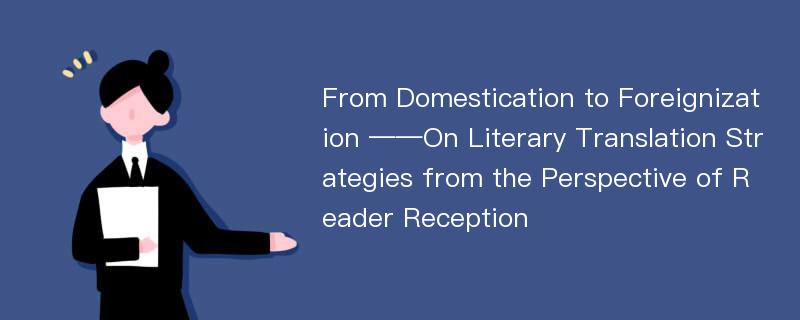
论文摘要
由于文学翻译本身所具有的特殊属性,作为翻译的两种策略,归化和异化一直是人们关注的对象,文学翻译中应以归化为主还是以异化为主也一直是人们争论的焦点。从我国古代佛经翻译开始,直到当代的西学翻译,此争论一直就没有停止过。20世纪80年代前我国的文学翻译都以归化为主调,此后人们开始重新审视这两种翻译策略的关系。当前,国内又掀起了新一轮的归化与异化之争。在以前的许多理论中,作者中心论和文本中心论占据绝对统治的地位,而没有考虑到读者的接受,更没有考虑到在翻译的过程中,译者会依据读者的接受来选用不同的翻译策略。20世纪60年代,以现象学和解释学为理论基础并以人的接受实践为依据的接受美学的诞生,使人们找到了一个新的研究方法,是方法论上的一个重大变革。正是通过接受美学中的读者期待视野、审美距离和视野融合等观点,本文重新探讨了归化和异化的问题,并指出翻译策略的选择是一个极为复杂的过程,在这个过程中,有三个因素起着主要的作用,那就是历史背景、译者动机和读者接受,其中又以读者接受为主导决定着翻译策略的走向。文章接着以林纾和鲁迅的翻译为例,指出归化和异化是译者在不同的时代背景下依据读者的接受能力而做出的不同选择。在经济全球化不断发展和文化交流日益频繁的今天,伴随着读者接受能力的不断提高,我们既不能想当然的认为翻译应当以异化为主,也不能过低的估计归化的作用,更不能采取折衷的态度。而是应当看到,这是一个渐进的、逐步发展的过程,其总体趋势则是从归化到异化的辩证运动,我们当前所有的翻译活动也都应遵循这一规律。
论文目录
相关论文文献
- [1].The Translation Methods that Zhang Peiji used in the Rhetoric Translation[J]. 青春岁月 2016(23)
- [2].The Function of Chinese Quadrisyllabic Phrases in E-C Translation[J]. 校园英语 2017(05)
- [3].The Philosophical Interpretation and Comparative Analysis of Different Translations of the word “Dao”in Dao De Jing[J]. 青春岁月 2017(11)
- [4].A Study of “Untranslatability” from the Perspective of “Five Untranslated Categories” by Xuan Zang[J]. 校园英语 2017(18)
- [5].New Books[J]. China's Tibet 2017(03)
- [6].Keywords to Understand The Belt and Road Initiative[J]. Beijing Review 2017(28)
- [7].The Outflow of Emotions in Eileen Chang's Translation of The Old Man and The Sea[J]. 青春岁月 2017(13)
- [8].Keywords to Understand The Belt and Road Initiative[J]. Beijing Review 2017(23)
- [9].Keywords to Understand The Belt and Road Initiative[J]. Beijing Review 2017(32)
- [10].Keywords to Understand The Belt and Road Initiative[J]. Beijing Review 2017(27)
- [11].Keywords to Understand The Belt and Road Initiative[J]. Beijing Review 2017(31)
- [12].Keywords to Understand The Belt and Road Initiative[J]. Beijing Review 2017(34)
- [13].Chinese Poetesses and Rexroth[J]. 校园英语 2017(25)
- [14].Study of Subjectivity on the Basis of the Translation of Le Rouge et le Noir by Xu Yuanchong[J]. 校园英语 2017(28)
- [15].Keywords to Understand The Belt and Road Initiative[J]. Beijing Review 2017(39)
- [16].Keywords to Understand The Belt and Road Initiative[J]. Beijing Review 2017(36)
- [17].Keywords to Understand The Belt and Road Initiative[J]. Beijing Review 2017(35)
- [18].Keywords to Understand The Belt and Road Initiative[J]. Beijing Review 2017(Z2)
- [19].热词释义[J]. 孔子学院 2011(04)
- [20].The Evolution of Translating the Chinese News Term “Fusion Media”[J]. 校园英语 2020(20)
- [21].THREE BODYIS BACK[J]. The World of Chinese 2015(06)
- [22].咱雅班第達翻譯過兩部《八千頌》嗎?(英文)[J]. 西域历史语言研究集刊 2020(01)
- [23].Analyze Obama's State of the Union 2015——From the Perspective of Halliday's Systemic Functional Grammar[J]. 海外英语 2019(21)
- [24].Indeterminacy in the Translation of Life by George Herbert[J]. 海外英语 2017(09)
- [25].E-C Translation of While-clauses—A Parallel-corpus-based Study[J]. 海外英语 2011(12)
- [26].On the Initiative of Chinese Culture "Going Out"[J]. 学术界 2016(07)
- [27].ZHEJIANG PENGUIN SPECIALS[J]. The World of Chinese 2019(06)
- [28].TWO LIVES[J]. The World of Chinese 2020(04)
- [29].An Analysis of the Feminism in the Translation of The Old Man and the Sea by Eileen Chang[J]. 校园英语 2015(12)
- [30].PEOPLE[J]. Beijing Review 2014(10)
